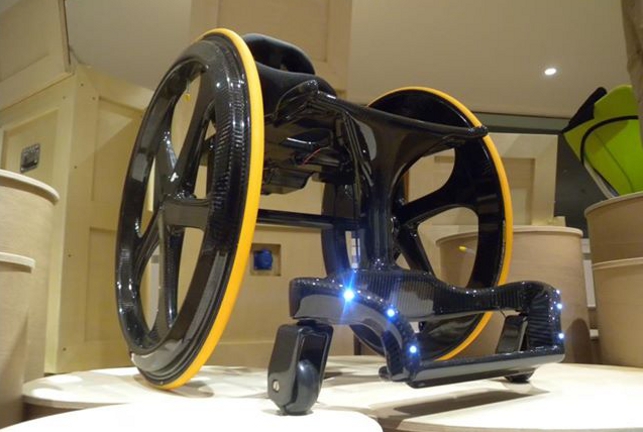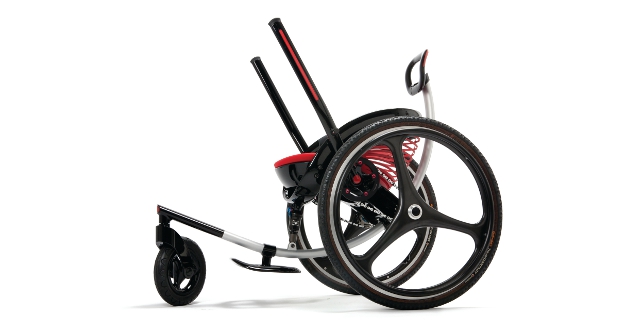Bringing sexy back
Andrew Slorance has dedicated the past six years of his life to designing and developing his perfect wheelchair.

Having fallen from a tree at the age of 14, which left him paralysed from the waist down, he has always been frustrated by the limitations and lack of appeal of wheelchairs.
With his wife challenging him to make a chair that was ‘super sexy looking’ he left his job as a senior video editor at Sky Television to set up I-Imagine Design in Nairn, Scotland, to bring his idea for a carbon fibre wheelchair to life.
Using SolidWorks for the CAD work, he sank all his savings into designing and prototyping his sleek Carbon Black Wheelchair.
The wheelchair caught the eye of the design fraternity when it was nominated for the Design of the Year 2012 awards, organised by the Design Museum. “Of course I was disappointed not to win but we got great exposure in the design world, which is what the chair is all about – great design rather than a medical device,” says Slorance.
Investment has always been a massive challenge but now with Inverness-based investors onboard, he has been able to make a number of refinements to the design.
“The monocoque has been slightly redesigned to even better spread stresses and loads and the aesthetics have also been further streamlined.
“The chair now has integral hub locks which via a neat moulded lever releases a sprung locking pin into a disc on the wheel. The LED lights are brighter than the prototype and are directional so the user can set them exactly as they want.
“The backrest has been streamlined and uses a highly engineered solution for scoping up and down so the user can choose their backrest height as and when they want while on the move.”
Manufacturing is taking place in Oxfordshire and if all goes well, the chair is expected to be on sale in July/August via the website.
“The chair has a complete set of new tooling and will be made in fewer parts than previously. The result of this should be a lighter and even stronger structure,” comments Slorance.
Sporty number
Back in 2005 a PhD graduate student from the Massachusetts Institute of Technology (MIT) department of Mechanical Engineering, Amos Winter, travelled to Tanzania as part of his research into how wheelchair technology met the mobility needs of users.

What he found was pretty dire. Many in need of a wheelchair just didn’t get around and those that did have access to one could not get very far anyway due to narrow doorways, steep hills and rough terrain.
Winter knew that something had to be done. He formed the Mobility Lab at MIT with some fellow students and they soon got to work on an off-road, lever-powered wheelchair.
The idea behind it was simple: instead of pushing on the wheels, users push on two levers instead. For rougher terrain, the user grips the levers higher up for greater torque and for smoother terrain, they grip lower down to get the wheels turning more swiftly.
The Mobility Lab team created some initial prototypes of this Leveraged Freedom Chair (LFC) using predominantly bicycle parts. The thinking behind this was that it could be made locally using inexpensive construction techniques and would also be easier to repair and fix.
The prototypes were tested with users in a number of East African countries. With the feedback they received Winter and his team realised that they’d need to get industrial designers on board to improve on the design.
In 2010 he approached Continuum, a global design and innovation consultancy, whose initial advice was to develop a high performance version of the wheelchair for the first world, the sales of which could fund the original prototype.
This was similar to the model for the One Laptop per Child program that Continuum helped develop.
Armed with their design tools – firstly pen and paper and then later Adobe Illustrator, Adobe Photoshop and SolidWorks – the designers created a design for the LFC Sport, a lightweight,
high performing chair made from aluminium and carbon fibre.
It was composed of two defining design elements: an arching spine and closed loop. These elements determined the chair’s look and how it would be constructed.
The team decided tentatively on a ‘buy one, give three’ approach, wherein one first-world wheelchair would pay for three in developing countries. They also formed a social enterprise, GRIT to bring the LFC to market.
Production of the LFC for developing countries is underway in India. Meanwhile, the LFC Sport, which has won a number of design awards, is in the latter stages of development and the team hopes to introduce it to the US market later next year.
Grow together
Product design consultancy Renfrew Group in partnership with the NHS has unveiled a wheelchair system – Chair4Life (C4L) – that ‘grows’ with a disabled child as he or she journeys into adulthood.

“We believe we’ve developed an innovative, modular wheelchair that’s truly adaptable to an individual’s changing needs and addresses the physical and social demands of 80 per cent of paediatric, powered wheelchair users aged 4 to 18 years old,” says Bruce Renfrew, the company’s design director.
The Renfrew design team adopted a user-centred design approach and engaged ergonomics consultancy David Hitchcock Ltd to provide reactive input into the C4L project. User groups also provided invaluable feedback that helped inform the design.
ProEngineer was used exclusively for the CAD modelling of the mechanical systems and the aesthetic parts whilst renderings were carried out in Autodesk VREDPro 2014 and Octane Render. Most of the prototyping was done in-house using high speed CNC machining in aluminium, plastics and metal fabrications.
“We have an extensive workshop facility including a pattern shop, tool room, mould shop auto-studio and various fabrication studios and assembly areas, so we can tackle most things our clients throw at us,” says Renfrew.
In terms of manufacturing, the consultancy is currently negotiating with a number of interested parties. “The automotive industry is showing a keen interest especially as the designs have been configured to allow for both batch manufacturing and higher volume production.”
A look at the latest innovations in wheelchair design
Default






